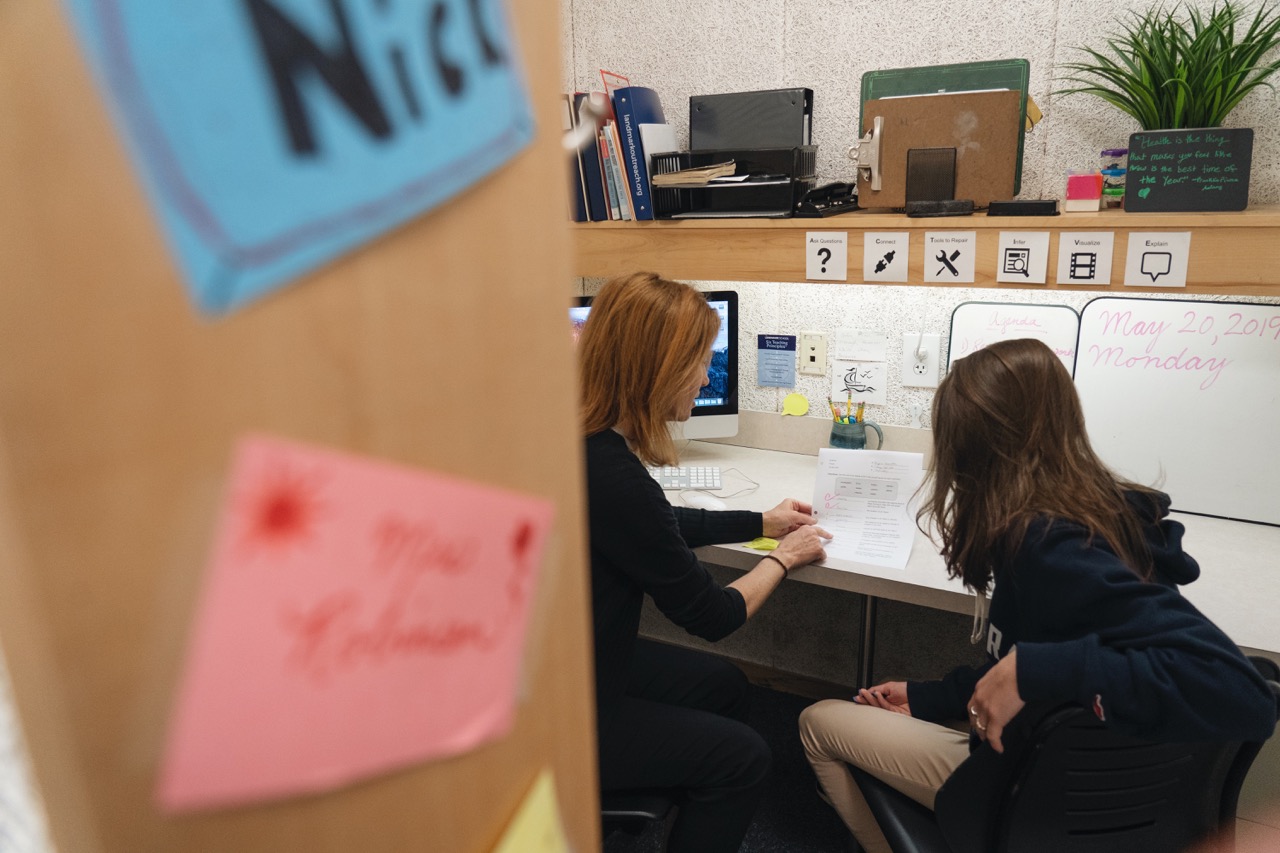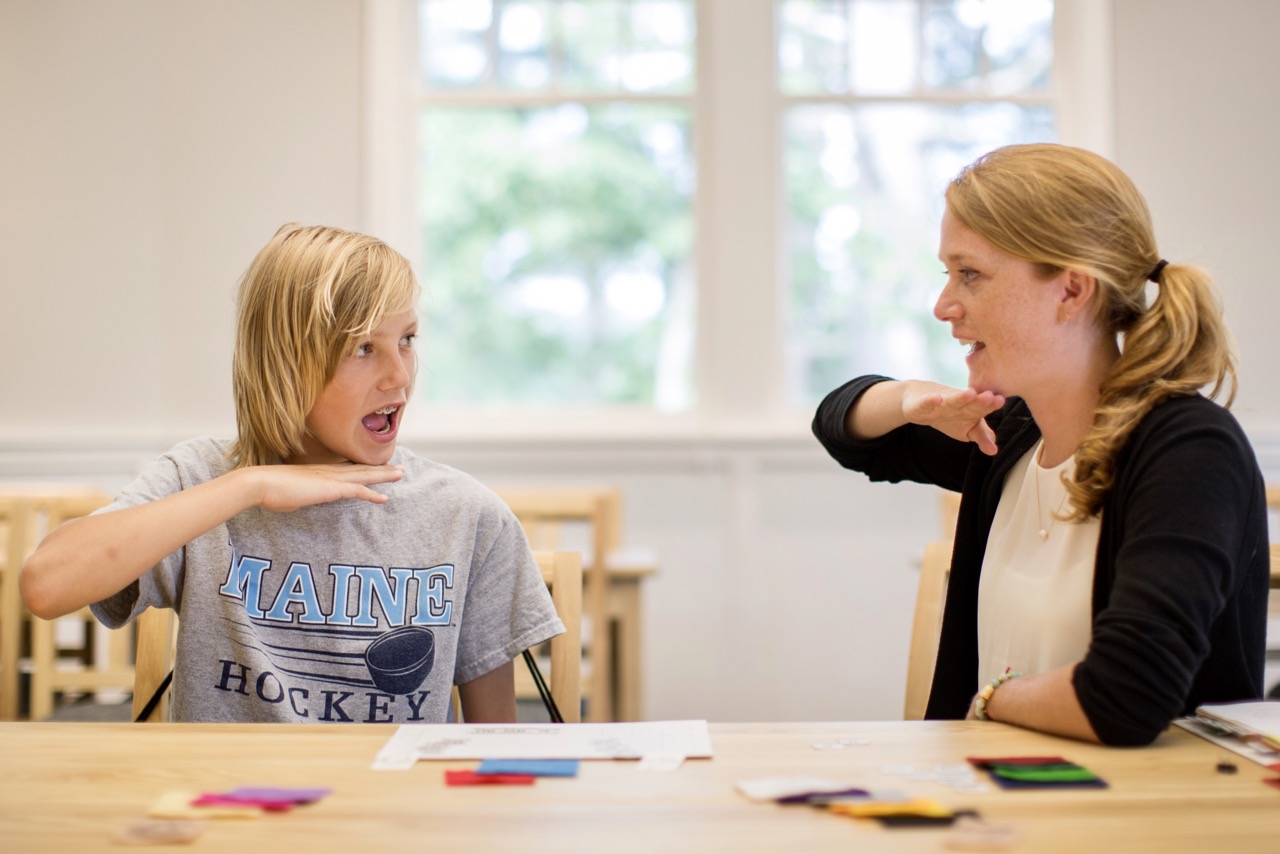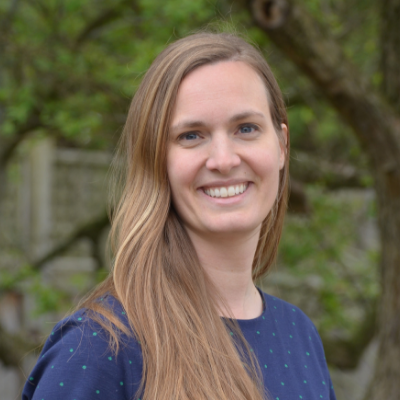- Our School
- Our Advantage
- Admission
- Elementary•Middle School
- High School
- Summer
- Giving
- Parent Resources
- For Educators
- Alumni
« Back
Helping Struggling Readers
January 17th, 2023
Finding the Right Reading Tutorial Program
A book slams shut. A clear sign that my student has reached her frustration level with her short reading assignment. After a few afternoons of tears because she is noticing she just can’t keep up, it’s time to do something. Reading just isn’t working.
If you have had a similar experience with a child struggling with reading, you aren’t alone.
About 10-20% of the population struggles with reading. Many have a condition called dyslexia. People with dyslexia are capable, good problem solvers, connectors, and innovators. While there is a lot of good that comes from having dyslexia, when living in a world built on reading, struggling with literacy skills can make a student’s path challenging.
Luckily, there is a large body of scientific research supported by ongoing neuro-imaging of the brain during reading tasks. This process can analyze the phenomenon of reading and identify approaches that are supported by this research to help people with dyslexia learn to read. The earlier a child receives intervention, the more successful the outcome. So, don’t wait!
As you begin your journey to find help for your struggling reader, there are several programs you should be aware of. Below are a few common methods of teaching reading.

Orton-Gillingham
The Orton-Gillingham approach combines time-tested knowledge and practices with scientific evidence about how individuals learn to read. This method usually relies on a one-to-one model, with one teacher working with one student—but it can also be effective with small groups of students. While instructors are intensively trained, Orton-Gillingham is an approach, not a program. Tutors create their own lessons and materials in order to individualize instruction for each student. While Orton-Gillingham works for many students, it doesn’t provide enough structure at the sound level of phonemes for others. (1)
Learn more about the Orton-Gillingham approach.(1)
Wilson
“The Wilson Reading System® (WRS) is an intensive Tier 3 program [grades 2-12 and adults]3…As a structured literacy program based on phonological-coding research and Orton-Gillingham principles, WRS directly and systematically teaches the structure of the English language. Through the program, students learn fluent decoding and encoding skills to the level of mastery. “ The Wilson program is designed for one-to-one or small-group settings of up to four students.(2)
Learn more about the Wilson Reading System.(2)
LiPS
The Lindamood Phoneme Sequencing® Program for Reading, Spelling, and Speech (LiPS®) is an evidence-based program typically administered in one-to-one or small group settings. “The LiPS Program focuses on the ability to distinguish phonemes (single speech sounds) in spoken patterns. In teaching sound-symbol associations, the LiPS tasks progress from movement to sounds to letters. Students explore the physical movements that are involved in producing sounds, learning to hear, see, and feel the physical characteristics of sounds and notice the contrast between them. Students learn to independently identify and verify sounds they produce, hear, and eventually, read.” (4)
Learn more about the LiPS Program.(4)

What To Look For In a Reading Program
Every reading program has its merits and the ones listed above have many similarities. If one program doesn’t work for your child another may.
When looking for a reading program for your child make sure it is:
- Diagnostic - The program should give your child a battery of tests/activities to diagnose the areas that need support.(5)
- Prescriptive - The program should be flexible enough to be able to meet the needs of your child regardless of where they are in their reading journey.(5)
- Research-Based - Instruction should only be used because research has shown that it works.
- One-to-One - One teacher working with one student allows a truly customized model for the student. The one-to-one tutorial model is the “gold standard among interventions for struggling readers.” (6)
- Systematic, Sequential, and Structured - The program should explicitly teach a comprehensive progression of speech sounds, and the letters that represent them, in a specific order or sequence. (7)
Finding A Reading Program
There are many different ways that reading programs are disseminated.
- Special Education in School Districts - Ask your school district if they have specialized reading programs for struggling readers and how your child can qualify for that service.
- Centers/Tutors - If your child needs support outside of school, there are centers and tutors all around the country that provide after-school reading programs and tutorials.
- Independent Schools - There are entire schools dedicated to helping struggling readers. Some are fully private and must be funded by the family, while others accept funding from school districts who can’t meet the child’s needs.

Landmark School’s Reading Tutorial
There are some programs, such as the Landmark School individualized tutorial program, that does not prescribe to one set reading paradigm but aligns with the programs above, as well as other research-based practices, to find what works best for their students.
Landmark is an independent school that specializes in empowering students with dyslexia and other language-based learning disabilities.
Landmark School’s Reading Tutorials are:
- One-to-one - One teacher working with one student in their own space for the full time-block. The student has the full attention of the teacher for the entire time with no distractions from other students.
- Graduated - As students build skills and confidence, the challenge and focus of their tutorial will evolve to match their growing independence.
- Diagnostic - During the admission process, every student goes through a battery of assessments to discover their areas of need and matching a teacher to their specific learning profile. The tutor then continues to administer diagnostic testing at the beginning and end of each school year, as well as check-points along the way, to make sure the student is supported effectively.
- Flexible but Structured - All Landmark tutors have extensive onsite training and many receive training in how to implement the LiPs program, which teaches phonemic awareness and sound-symbol correspondences. Our approach to teaching reading draws on the same scientific foundation and principles as Orton-Gillingham, but they are not locked into one program. All tutors, supported by academic advisors and knowledge gleaned from the diagnostic testing, pull from a battery of research-based methods to find what works best for their student. All tutorials use a systematic, sequential, and structured approach.
- Integrated - Landmark School integrates the reading tutorial within the student’s academic schedule. It feels like just another class during the school day. It isn’t a pull-out or in another location or with different teachers. The tutorials are taught by instructors who may also teach a content area class. This helps inject reading tutorial concepts throughout the other academic curriculum.
Learn more about the Tutorial and Teaching Reading at Landmark School.
Other Resources
As a parent, realizing your child is struggling can be emotional. Take a deep breath. There are lots of resources available to you. Start by taking some time to educate yourself.
Below are some resources that can help guide you:
- A Guide to Early Markers of Dyslexia
- Tips for Parents Who Suspect Their Child Has a Learning Disability
- Psychoeducational and Neuropsychological Evaluations Explained
- Navigating the IEP Process: Tips for Parents
- Teaching Reading: The Diagnostic-Prescriptive Approach
You can also turn to national organizations for parent support.
- Decoding Dyslexia - a network of parent-led grassroots movements across the country concerned with the limited access to educational interventions for dyslexia within the public education system.
- International Dyslexia Association - non-profit organization that provides resources, helps track legislation, and has an annual conference
- Made by Dyslexia - A global charity, led by successful individuals with dyslexia. Their purpose is “to help the world to Learn Dyslexia: to understand it, to value it and to support it.”
- Understood.org - A non-profit whose mission is to “To help those who learn and think differently discover their potentials, take control, find community, and stay on positive paths along each stage of life’s journey.”
Citations
- Orton-Gillingham Academy. (2019, February 19). What is the orton-gillingham approach? Academy of Orton-Gillingham Practitioners and Educators. Retrieved December 13, 2022, from https://www.ortonacademy.org/resources/what-is-the-orton-gillingham-approach/
- Wilson Reading System. Wilson Language Training. (n.d.). Retrieved December 13, 2022, from https://www.wilsonlanguage.com/programs/wilson-reading-system/
- MTSS & RTI Listen. Wilson Language Training MTSS RTI Comments. (n.d.). Retrieved December 13, 2022, from https://www.wilsonlanguage.com/programs/highlights/mtss-rti/
- Lindamood phoneme sequencing® program for reading, spelling, and speech (LiPS®). Lindamood Bell Learning Process. (2021, August 25). Retrieved December 13, 2022, from https://lindamoodbell.com/program/lindamood-phoneme-sequencing-program
- Howard, P. (2022, October 31). Teaching Reading: The Diagnostic-Prescriptive Approach [web log]. Retrieved November 16, 2022, from /our-school/landmark-360-blog/?id=306128/teaching-reading.
- Slavin, R. E., Lake, C., Davis, S., & Madden, N. A. (2009, June). Effective Programs for Struggling Readers: A Best-Evidence Synthesis. Johns Hopkins University School of Education’s Center for Data-Driven Reform in Education. Retrieved November 14, 2022, from /uploads/files/Our_Advantage/strug_read_Jun_02_2010.pdf
- Moats, D. L. (2021, May 20). Speech to print or print to speech? it makes a difference. Voyager Sopris Learning. Retrieved November 14, 2022, from https://www.voyagersopris.com/blog/edview360/speech-to-print-or-print-to-speech-it-makes-a-difference
About the Author
Kimberly Hildebrandt worked on this article in collaboration with Landmark experts at the Elementary•Middle School and High School Campuses. Kimberly has been working at Landmark School since 2005.

Posted in the category Learning Disabilities.






















